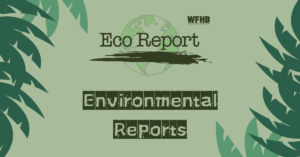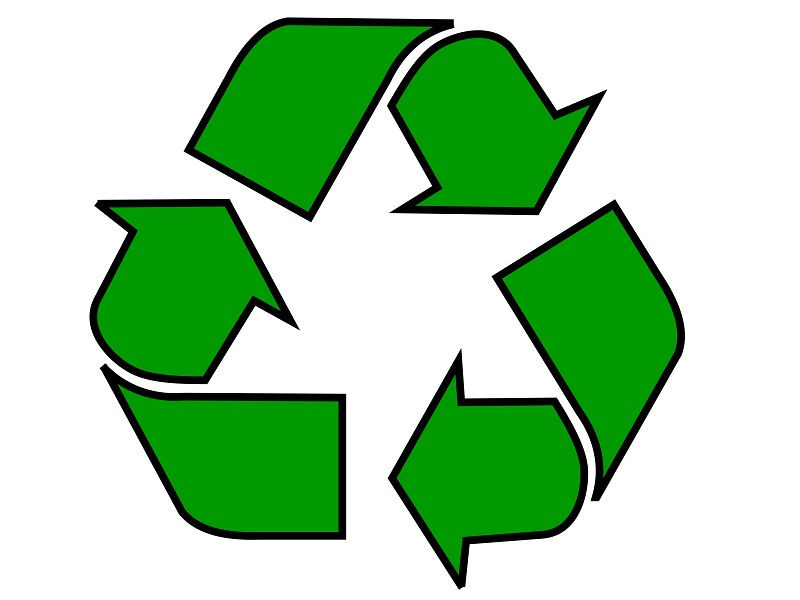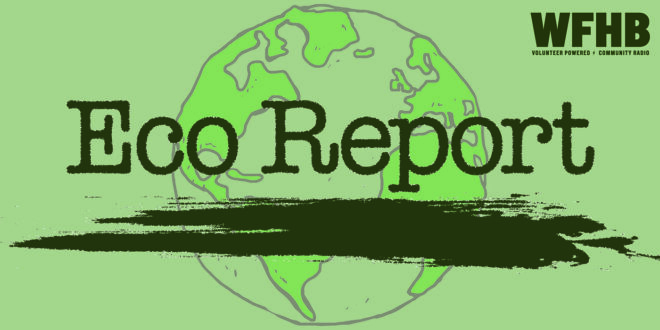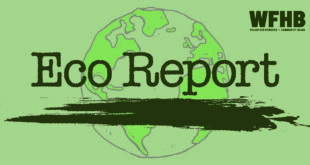Podcast: Play in new window | Download (Duration: 29:34 — 27.1MB)
In this week’s Eco Report feature we hear from Elisa Pokral, Community Outreach Coordinator of the newly rebranded Waste Reduction District of Monroe County, in Part Two of a conversation with Environmental Correspondent Zyro Roze.

- The stocks of the most desirable species, for example, codfish and halibut, are less than one percent what they were in 1600. There are no virgin areas left in the oceans. Most areas now have less than ten percent of the fish they had at 1600.
- The fish in the northern hemisphere are the most depleted because the majority of the human population lives in the northern hemisphere.
- There are pluses and minuses in selecting either wild-caught or farm-raised seafood. The bottom line is that there are not enough wild species left in the ocean to satisfy the demand. Approximately two billion people get their only animal proteinfrom seafood. Most of this population lives in poor countries where fishing is done by canoe or small boats. They fish in territorial waters.
- Farm-raised fish are more readily available and less expensive than wild-caught fish, and they face some of the same problems as large-scale farms on land. Pollution of natural habitats is also a concern with fish grown in open-net cages. A unique problem with farmed fish is that those raised in nets can introduce diseases and pests to wild populations. A few years ago in Norway, farmed salmon infected the country’s wild salmon with sea lice, significantly decreasing the population of wild salmon. Farmed salmon will also sometimes escape their enclosures, mating with and overtaking wild salmon species. Farm-raised fish tend to have higher fat content, since wild fish get more exercise, and because farmed fish are typically given feed high in fat from sources such as fish oil. That includes healthy fats such as omega-3 fatty acids, as well as saturated fat. Wild-caught fish may contain more trace minerals, while farmed fish may contain more sodium. Nutritional differences between farmed and wild-caught shellfish, however, are minimal.
- The least expensive way to protect wild species is to form preserves. These are areas that cannot be fished. Fishermen arealways happy to set side areas where there are no fish, but they oppose setting aside areas with abundant numbers. Enforcement requires that a government vessel must go out to the preserve and visually see that the intruder is fishing. This requirement effectively means that poor countries cannot defend their territorial waters. Fishermen have successfully prevented following all boats from shore. We have the technology to locate where every boat is. What is needed is acceptance of monitoring from shore, plus the power to seize a boat if it enters a preserve area.
- Preserves need to be established in the Arctic Ocean, and off Antarctica. Given that the rest of the oceans will be too warm for species such as cod, the polar waters will become the last refuge of cold-water fish. As the Arctic ocean warms, the number of days it will be ice-free will increase, bringing increased pressure from nations to fish. The Arctic ocean will be ice-free long before the Antarctic Ice Cap melts completely.
- As the glaciers melt, the oceans will rise, which will bring new areas into the possibility of fishing. For example, if the oceans increase by 50 feet, much of the Florida Peninsula will be under water. Thus, will the buildings of Miami be occupied by creatures of the sea?
The trend of consuming more and more farm-raised fish will continue. As the water temperatures rise, many of the original stocks may leave, replaced by completely different species.
How much do you know about plastic? If you are like most people, you have it in your kitchen as plastic food wrapper bags, or saran wrap, or plastic film over a container that is also make of plastic. In fact, plastic is everywhere. Not only is it used to hold produce or other foods, it is now in the food you eat, your soil and also in your body. Plastic does not go away or compost down. It breaks into smaller and smaller pieces until it becomes microscopic, but it is still there. So I thought a little history lesson on plastic might be interesting to some of you. I grew up before it was a “big thing” in the kitchen. Milk came in bottles, my sandwich for lunch was wrapped in wax paper, I used a paper bag to carry my lunch. My mother put leftovers in metal containers or glass jars. However, it was around. Just not as obvious. Our TV had a plastic frame around it. It was very hard and didn’t break.
In this week’s Eco Report feature we hear from Elisa Pokral, Community Outreach Coordinator of the newly rebranded Waste Reduction District of Monroe County, in Part Two of a conversation with Environmental Correspondent Zyro Roze.

- Take a Full Moon Hike at Brown County State Park on Saturday, March 23rd from 8 to 9 pm. Enjoy a guided hike around Lake Strahl to learn all the history and folklore of the Full Worm Moon. The trail is considered easy but more rugged in the dark.
-
Plan to participate in a Cultivating Mushrooms at Home class at the Allison-Jukebox Community Center on Tuesday, March 26th from 6 to 8 pm. Learn the benefits of having mushrooms in your diet and how to grow mushrooms. Register at bloomington.in.gov/parks.
-
Make a Solar Eclipse Viewer at Spring Mill State Park on Saturday, March 30th from 11 am to Noon. Learn about the solar eclipse and how to safely view the sun. Meet at the Lakeview Activity Center. Please register in advance.
-
Enjoy a Bluebird Nest Box Building Workshop at McCormick’s Creek State Park on Saturday, March 30th beginning at 1 pm. The Brown County Bluebird Club will teach you all about these birds while you build your very own bluebird box. Register to Dan Sparks at [email protected] or call 812-200-5700.
- There will be a Woodcock Walk at Goose Pond Fish and Wildlife Area on Saturday, March 30th from 6 to 7:30 pm. Enjoy an evening excursion to watch the American Woodcock perform it mating ritual – the ‘Sky Dance.’ Dress for the weather and be prepared for muddy conditions.
Credits:
This week’s headlines were written by Norm Holy and Julianna Dailey.
Today’s news feature was produced Zyro Roze and edited by Kade Young.
Julianna Dailey assembled the script which was edited by the Eco Report team.
Julianna Dailey compiled our events calendar.
Kade Young and Noelle Herhusky-Schneider produced today’s show.
Branden Blewett is our engineer.
Anchors are Julianna Dailey and Cynthia Roberts.
Are you looking for a way to make a difference on environmental issues? Eco Report is looking for reporters, engineers, and segment producers who are passionate about reporting facts on how we’re all affected by global climate disruption and the ongoing assaults on our air, land and water. We also celebrate ecologists, tree huggers, soil builders and an assortment of champions who actively protect and restore our natural world, particularly those who are active in south central Indiana. All levels of experience and all ages are welcome, and we provide the training you’ll need. WFHB also offers internships. To volunteer for Eco Report, give us a call at (812) 323-1200, or e-mail us at: [email protected].

Are you one of those people who believes our Mother Earth is getting dirtier and dirtier from all our trash? Here are a few tips to help keep the Earth cleaner.
- Stop buying Styrofoam items. Styrofoam is forever. It is not biodegradable, so instead invest in some reusable mugs that you can take with you.
- Do you like to eat salmon? Several studies have found that PCB’s, which is a class of toxic chemicals, and other environmental toxins are present at higher levels in farm raised salmon than wild salmon. Look for safe seafood when shopping for salmon.
- What about those coffee filters? Are you a coffee drinker? Dioxins, chemicals formed during the chlorine bleaching process, contaminate groundwater and air and are linked to cancer. Start buying unbleached paper filters or use reusable filters.
- We all love to go to picnics, especially when the weather is nice. The next time you host or attend a picnic, bring your own utensils and food containers. Plastic forks, spoons, straws, and all that plastic stuff you see at a picnic are not biodegradable and not recyclable.
- One more thing you might want to stop using is paper towels. Regular paper towels are bleached, and waste forest resources and landfill space. Look for recycled, non-bleached paper towels or better yet, buy dishtowels or rags to wash and reuse.
Thank you for protecting Mother Earth. Keep looking for ways you can make a difference!
 WFHB Bloomington Community Radio
WFHB Bloomington Community Radio


